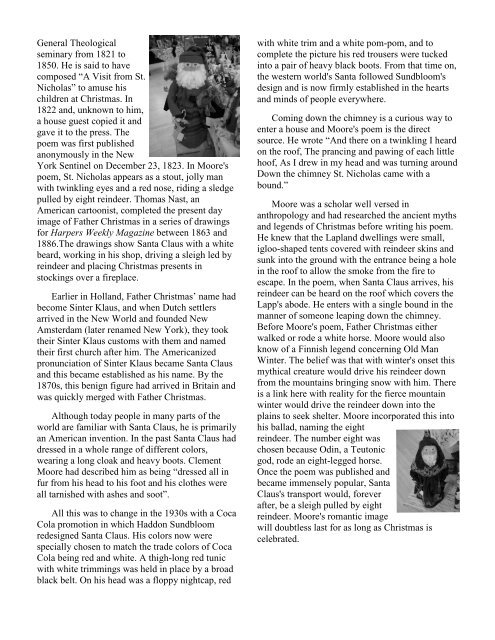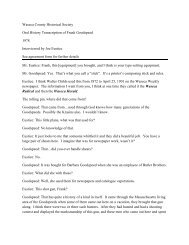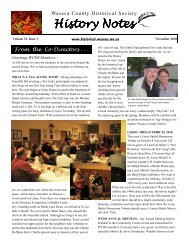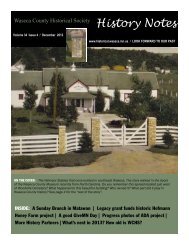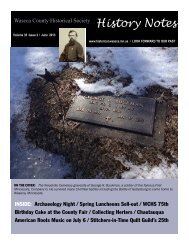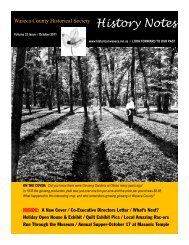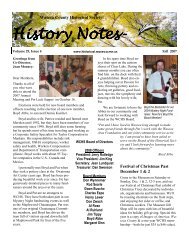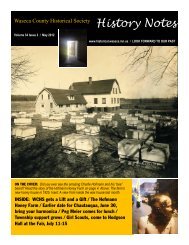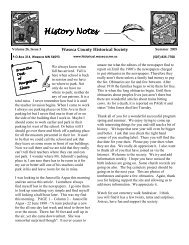Fall - Waseca County Historical Society
Fall - Waseca County Historical Society
Fall - Waseca County Historical Society
You also want an ePaper? Increase the reach of your titles
YUMPU automatically turns print PDFs into web optimized ePapers that Google loves.
General Theological<br />
seminary from 1821 to<br />
1850. He is said to have<br />
composed “A Visit from St.<br />
Nicholas” to amuse his<br />
children at Christmas. In<br />
1822 and, unknown to him,<br />
a house guest copied it and<br />
gave it to the press. The<br />
poem was first published<br />
anonymously in the New<br />
York Sentinel on December 23, 1823. In Moore's<br />
poem, St. Nicholas appears as a stout, jolly man<br />
with twinkling eyes and a red nose, riding a sledge<br />
pulled by eight reindeer. Thomas Nast, an<br />
American cartoonist, completed the present day<br />
image of Father Christmas in a series of drawings<br />
for Harpers Weekly Magazine between 1863 and<br />
1886.The drawings show Santa Claus with a white<br />
beard, working in his shop, driving a sleigh led by<br />
reindeer and placing Christmas presents in<br />
stockings over a fireplace.<br />
Earlier in Holland, Father Christmas’ name had<br />
become Sinter Klaus, and when Dutch settlers<br />
arrived in the New World and founded New<br />
Amsterdam (later renamed New York), they took<br />
their Sinter Klaus customs with them and named<br />
their first church after him. The Americanized<br />
pronunciation of Sinter Klaus became Santa Claus<br />
and this became established as his name. By the<br />
1870s, this benign figure had arrived in Britain and<br />
was quickly merged with Father Christmas.<br />
Although today people in many parts of the<br />
world are familiar with Santa Claus, he is primarily<br />
an American invention. In the past Santa Claus had<br />
dressed in a whole range of different colors,<br />
wearing a long cloak and heavy boots. Clement<br />
Moore had described him as being “dressed all in<br />
fur from his head to his foot and his clothes were<br />
all tarnished with ashes and soot”.<br />
All this was to change in the 1930s with a Coca<br />
Cola promotion in which Haddon Sundbloom<br />
redesigned Santa Claus. His colors now were<br />
specially chosen to match the trade colors of Coca<br />
Cola being red and white. A thigh-long red tunic<br />
with white trimmings was held in place by a broad<br />
black belt. On his head was a floppy nightcap, red<br />
with white trim and a white pom-pom, and to<br />
complete the picture his red trousers were tucked<br />
into a pair of heavy black boots. From that time on,<br />
the western world's Santa followed Sundbloom's<br />
design and is now firmly established in the hearts<br />
and minds of people everywhere.<br />
Coming down the chimney is a curious way to<br />
enter a house and Moore's poem is the direct<br />
source. He wrote “And there on a twinkling I heard<br />
on the roof, The prancing and pawing of each little<br />
hoof, As I drew in my head and was turning around<br />
Down the chimney St. Nicholas came with a<br />
bound.”<br />
Moore was a scholar well versed in<br />
anthropology and had researched the ancient myths<br />
and legends of Christmas before writing his poem.<br />
He knew that the Lapland dwellings were small,<br />
igloo-shaped tents covered with reindeer skins and<br />
sunk into the ground with the entrance being a hole<br />
in the roof to allow the smoke from the fire to<br />
escape. In the poem, when Santa Claus arrives, his<br />
reindeer can be heard on the roof which covers the<br />
Lapp's abode. He enters with a single bound in the<br />
manner of someone leaping down the chimney.<br />
Before Moore's poem, Father Christmas either<br />
walked or rode a white horse. Moore would also<br />
know of a Finnish legend concerning Old Man<br />
Winter. The belief was that with winter's onset this<br />
mythical creature would drive his reindeer down<br />
from the mountains bringing snow with him. There<br />
is a link here with reality for the fierce mountain<br />
winter would drive the reindeer down into the<br />
plains to seek shelter. Moore incorporated this into<br />
his ballad, naming the eight<br />
reindeer. The number eight was<br />
chosen because Odin, a Teutonic<br />
god, rode an eight-legged horse.<br />
Once the poem was published and<br />
became immensely popular, Santa<br />
Claus's transport would, forever<br />
after, be a sleigh pulled by eight<br />
reindeer. Moore's romantic image<br />
will doubtless last for as long as Christmas is<br />
celebrated.


